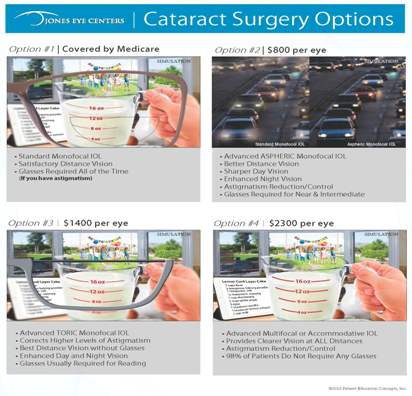
Before balanced billing there were no cataract surgery options. Today, with so many advanced IOLs and femtosecond cataract lasers, it can be difficult to explain your options and even more difficult for a layperson to understand and recognize the added value they would receive with each option. Too often, patients select an option because they feel pressured, or because they don’t want to appear ignorant, or they just say no to all the upgrades because they don’t understand them.
If there is one thing we know for sure, it’s that patients do not like surprises. Most patients still think that cataract surgery is covered by Medicare so if they did not know about advanced IOLs or laser cataract surgery before they came in, they were not expecting options. Imagine the stress of learning they have to have eye surgery immediately followed by having to muddle through a bunch of medical jargon that makes them even more anxious and confused about their next steps at remedying their cataract problem.
Many of our customers ask us for help sorting out and presenting their cataract and refractive surgery options. One recent customer had four “traditional (manual) cataract surgery” options and two “laser cataract surgery” options. He felt “he” had done a good job of writing out exactly what was included in each option. He also felt that 6 options were not too many because he would just recommend two or three of them after examining the patient.
Here is the original presentation of his four “Traditional Cataract Surgery” Options:
Option #1: A basic intraocular lens is provided that has ultraviolet protection. The lens is fully covered by Medicare and can provide satisfactory distance vision. Thin glasses are usually required to further focus the vision. Reading glasses or bifocals will be required. Cost?
Option #2: This option includes a premium aspheric IOL that can result in enhanced quality of vision. Based on preoperative testing, Dr. Jones will select a specific type of aspheric lens that will provide the best distance vision for you. In addition, an astigmatism reduction or control procedure is performed to further improve the overall quality of vision. The astigmatism procedure is performed by making a separate incision in the cornea. This package is not covered by Medicare. The cost of this package is $800 per eye.
Option #3: This package includes a custom ordered Toric implant to correct or reduce astigmatism. Its unique design can significantly improve distance vision without glasses. This implant is inserted in the eye and rotated to a specific angle to reduce astigmatism. This toric implant is preferred in eyes with higher degrees of astigmatism. Reading glasses are usually required. This package is not covered by Medicare. The cost of this package is $1400 per eye.
Option #4: This package includes a multifocal or accommodative implant that can provide both distance and near vision. Ninety-eight percent of Dr. Jones’ patients do not require any glasses postoperatively. The implants available are the Tecnis™ Multifocal, ReSTOR™ Multifocal, and the Crystalens™. Dr. Jones will determine which lens will be best for you based on preoperative measurements. An astigmatism reduction or control procedure is also included to improve the quality of vision. This package is not covered by Medicare. The cost of this package is $2,300 per eye.
Problems with his descriptions in the mind of the patient:
- Option #1 has ultraviolet protection – which sounds like a good thing but it does not seem to be included in the other options.
- Option #2 includes an aspheric IOL – no mention of the “nighttime” benefits of aspheric IOLs and there is no mention of the need for near and intermediate corrective lenses.
- Option #2 corrects astigmatism with “separate” incisions in the cornea – ouch! Not the best way to describe an LRI.
- Option #3 corrects higher degrees of astigmatism but is all that explanation about rotating the lens necessary? Reading glasses are needed but what about intermediate vision?
- Option #4 corrects distance and near (does not correct intermediate). This price is also $1000 cheaper than his laser cataract option with these lenses so it looks like a pretty good deal against his laser offering.
- Needs to be consistent as he discusses intraocular lenses, IOLs, Lenses, and Implants. What’s the difference?
What patients really need to understand is how each option will affect their postoperative vision. What is the best way to do that? USE PICTURES NOT JUST WORDS!
I think most of you will agree that 6 options is too many. We encourage practices to consider only 3 options – a basic monofocal Medicare package, a basic plus astigmatism-correcting distance vision package, and an advanced vision package that provides a full range of vision. Most practices that offer “good, better, best” options find that by having three options, the majority of their patients will upgrade to the “better” or middle offer, which can often be the most profitable option.
Explaining cataract or refractive surgery options does not have to be complicated or difficult. But if you are using a bunch of words to describe your offerings, you might consider getting professional help in creating your pricing collaterals. To learn more about PEC’s Visual Options Comparison Sheets, like the one shown above, click here or call us at 800.436.9126.

